


Fabulous walks, ancient history, gorgeous scenery and puffins!
Shetland pages:
Sumburgh Head, Ness of Burgi, Jarlshof
Old Scatness, St Ninian's Isle, Mousa
Lerwick, Scalloway
Eshaness, Stanydale Temple
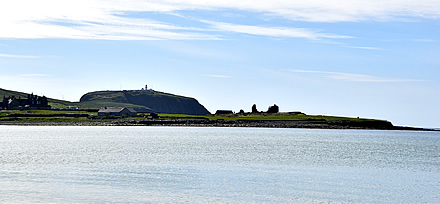
We stayed at the Sumburgh Hotel, right next to Jarlshof and within easy walking distance of Sumburgh Head. We had a lovely corner room on the upper floor with views up to Sumburgh Head and out over the sea to Fair Isle. We also spotted Harbour Porpoises making their way from the open sea across the bay.
The food here was excellent, some of the best we had on Shetland - really superb lamb and very good fish and chips. Though sunny it was quite cold so we also appreciated the hot roast parsnip soup they did us for lunch one day!
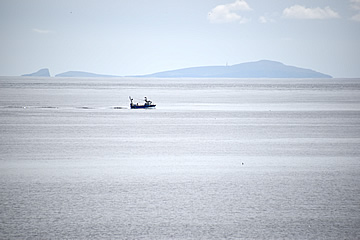
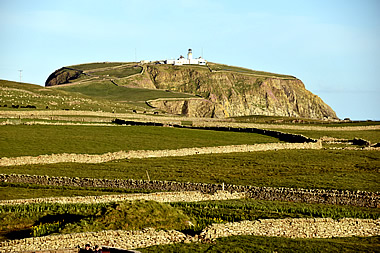
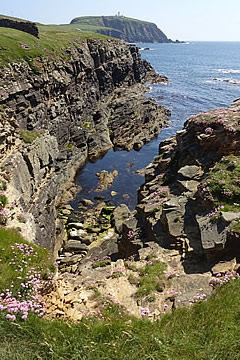
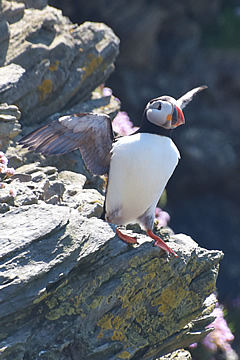
We ambled up to the lighthouse on Sumburgh on a gloriously sunny afternoon, our main aim to see the puffins.

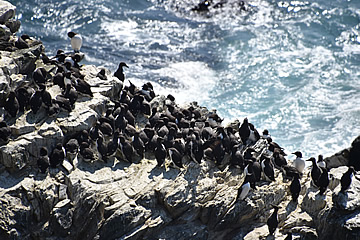
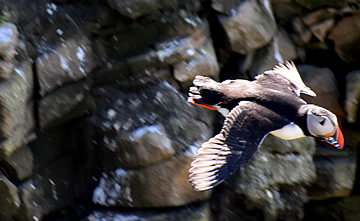
It's a really nice walk and there were a lot of puffins near the lighthouse on the grassy edges of the cliffs.

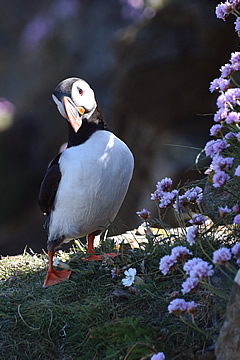
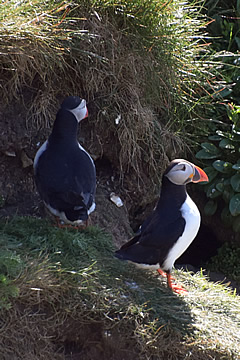
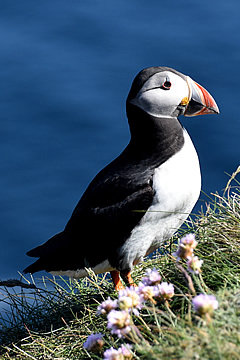
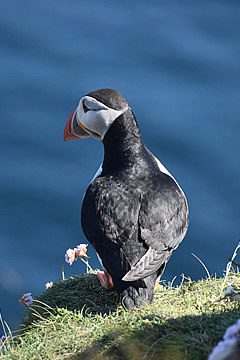
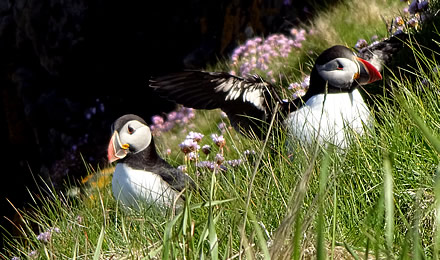

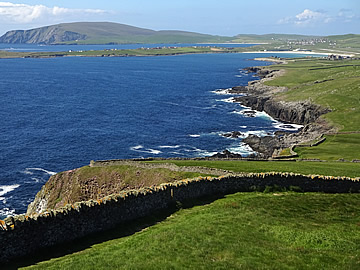
Seeing puffins was one of my aims for the holiday so I was especially happy!
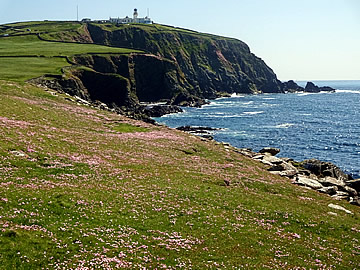
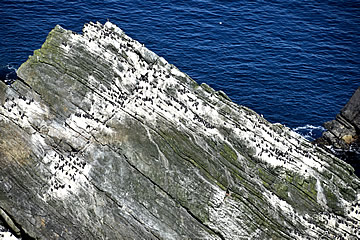
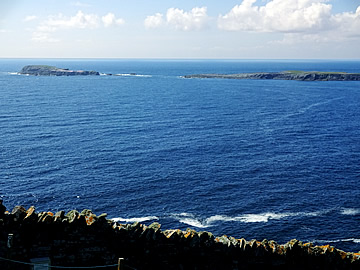
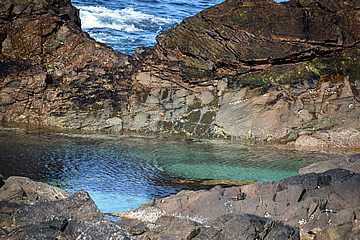
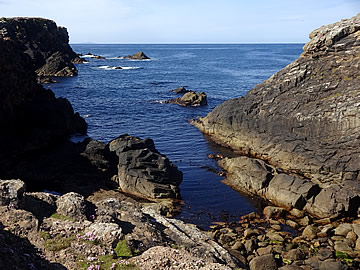
On another beautiful day we had a very gentle walk to the Iron Age fort on the Ness of Burgi, not far from the hotel, near the southern tip of Scat Ness stretching south from the western end of West Voe Beach. Ness of Burgi derives from Old Norse, "ness" meaning promontory, and "burgi" from borg meaning fort.1
The walk is lovely, mostly over grassland, with views all around, lots of seabirds. However, there are some quite difficult rocky sections to be negotiated including a very narrow, rocky stretch with a fixed chain to hold onto.
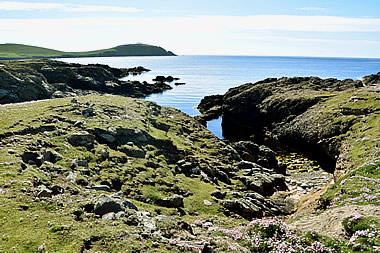
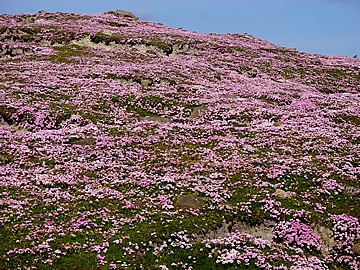
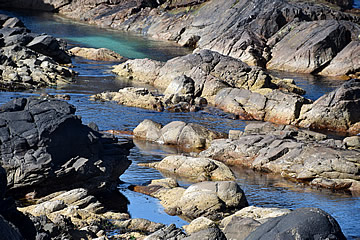
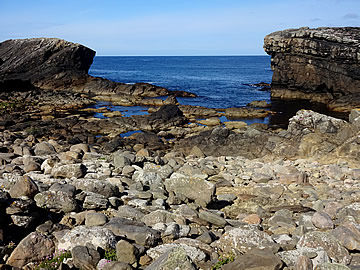
It's an impressive site, spanning almost the full width of the small south-east promontory, and would have been easily defensible, especially as there was a shallow, double ditch and massive bank1 on its northern side, and with great views out to sea - perhaps a lookout post?
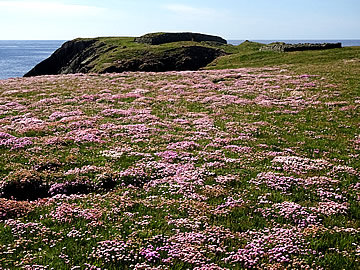

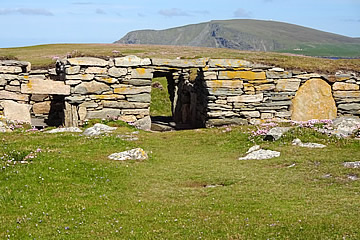
It is described as a blockhouse, rectangular in shape, built and occupied at much the same time as the brochs, perhaps around 100BC.
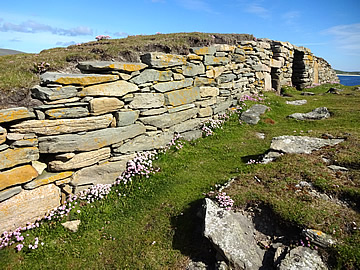
The structure measures approximately 23m by 5.5m with the walls surviving to a height of around 1.5m.1 There is an entrance on both the long north-west and south-east faces connected by a passageway.
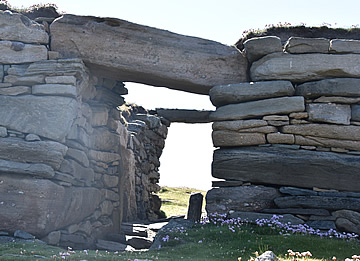
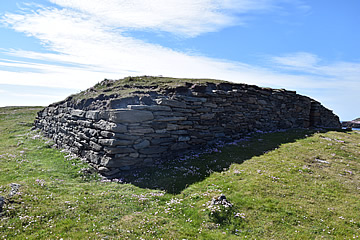
Off the passageway there is a large chamber on each side. The chamber on the north east side is entered from the passage, that on the south-west side has a low entrance on its south-east face.
On the south west end there is another chamber, the entrance to which has been lost. The north east end is neatly walled.
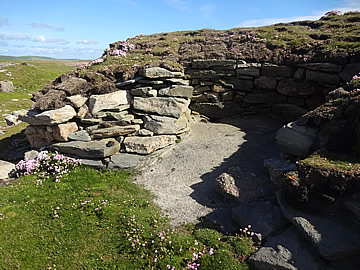
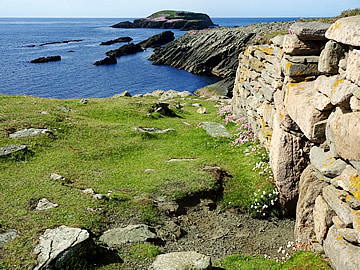
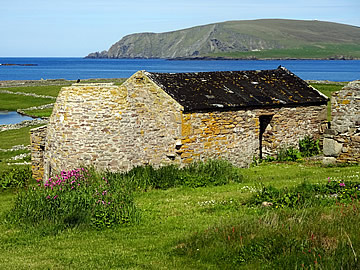
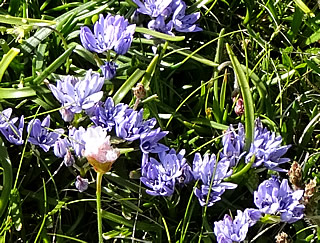
The fort would have been visible from nearby, but more ruinous, "Scatness North" fort, and the now largely destroyed, fort on Sumburgh Head, and also from Jarlshof. Forts that were visible to one another may have been instrumental in early warning of attack.
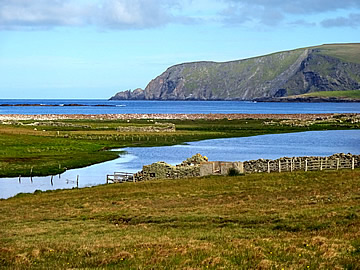
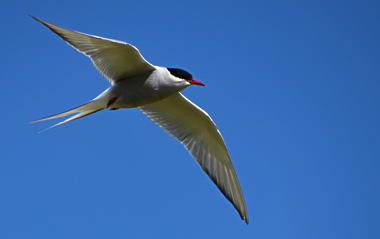
The curve of golden sand that is West Voe Beach stretches east from the north end of Scat Ness.

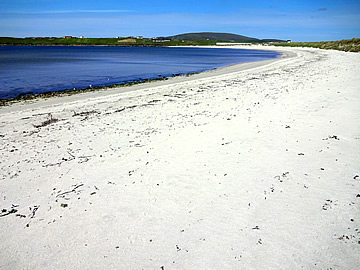
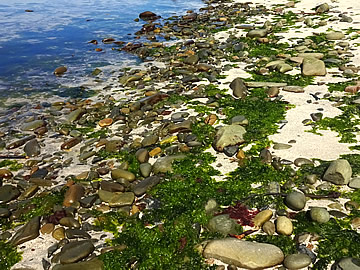
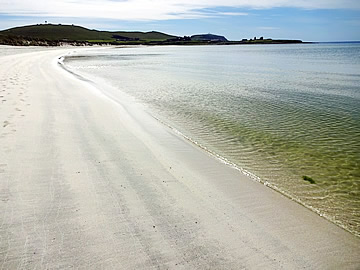
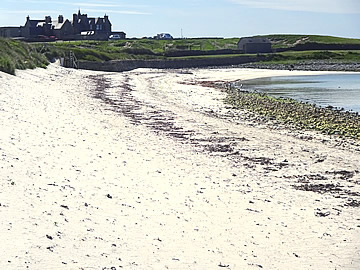
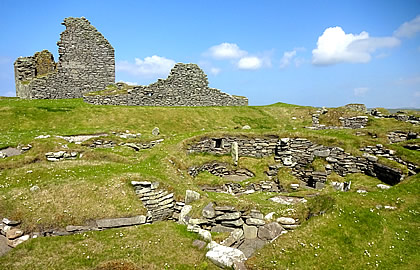
This remarkable archaeological site spans thousands of years, from the early Neolithic to the age of the Vikings. It was rediscovered in the late 19th century after a huge storm revealed traces of large structures around the Jarlshof - a Laird's home so-named by Walter Scott.2
The on-site notice boards and a very good Youtube video by Historic Environment Scotland help to identify the structures.
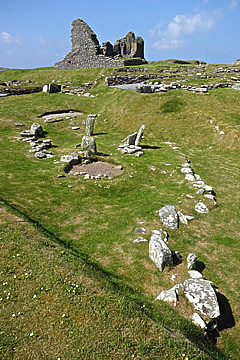
The location is little short of ideal for a settlement. The curved, shallow bay of West Voe is perfect for fishing and gathering shellfish and evidence from middens suggests shellfish were an important part of the diet. There are freshwater springs nearby, fertile land for agriculture, and good grazing pastures.
The earliest houses, from Neolithic times around 5,000 ago, were oval in shape, possibly roofed with wood and turf, though the wood was probably driftwood as trees were rare in Shetland.
The Neolithic structures are not well-preserved but display a bare interior with a central hearth.
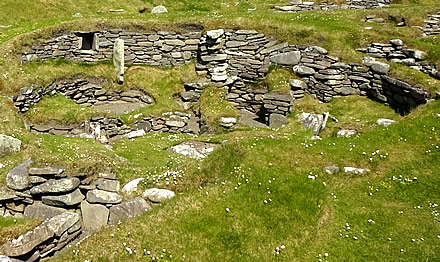
The Bronze and Iron Age structures are much better preserved, and there seems to be significant overlap in use.
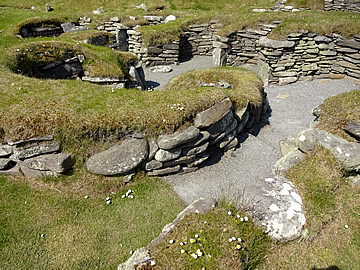
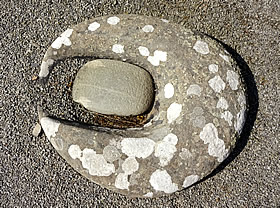
The Bronze Age homes, established some time between 2,000 and 1,500BC, were in use for an extended period. The earliest homes were oval with recesses, which may have been for beds, and may have had a central hearth. Later they became more circular, the central space expanded, and the recesses disappeared.
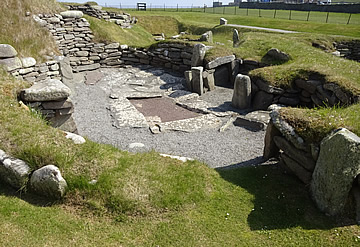
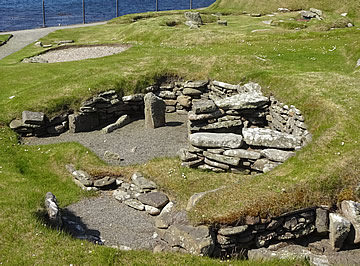
Around 800BC one of the Bronze Age houses was adapted to work as a smithy, with charcoal as fuel for the fire. Here molten bronze was poured into clay moulds to cast weapons, such as swords, and tools, such as axes.
The circular shape of the houses became more regular in the early Iron Age, around 600-400BC. Two of the Iron Age roundhouses have underground spaces which may have been used for storage or rituals.
Around 100BC, still the Iron Age, a large broch was built on the coastal side of the settlement. It has been severely eroded by the sea which has removed around half of the broch and adjacent areas, as a result of which an illuminating cross-section of the interior has been revealed.
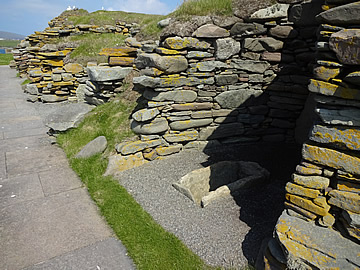
Double-walled and circular in shape this broch is fairly typical, around 20m external and 10m internal diameter, probably around 10m high. A 4m deep well is located in the middle of the floor and there is evidence of at least one upper floor.
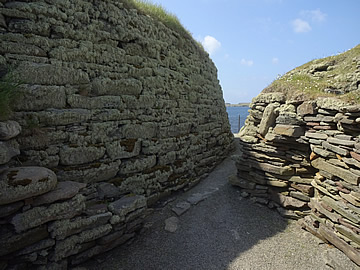
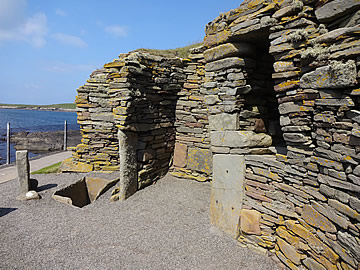
Not long after the broch was built, a walled courtyard was added on its western side, the wall curving round to meet the broch on its northern side.
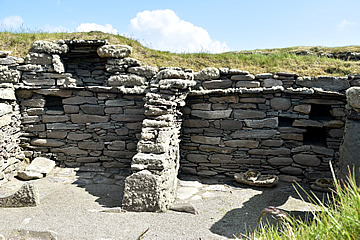
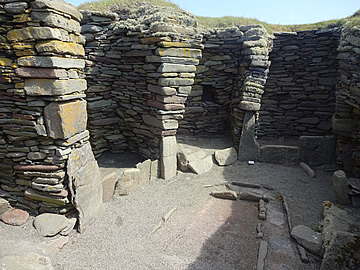
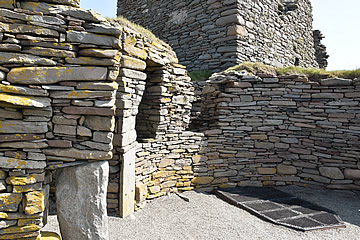
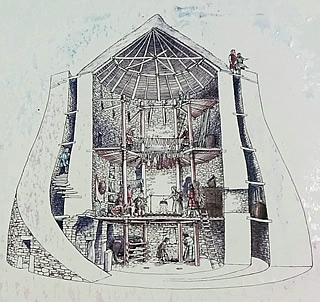
Within the courtyard a number of houses were erected, not quite circular, soon replaced by circular wheelhouses, and one wheelhouse was built inside the broch, which had probably been reduced in height. Jarlshof has the best examples of wheelhouses discovered anywhere. These wheelhouses date from some time around 200AD.
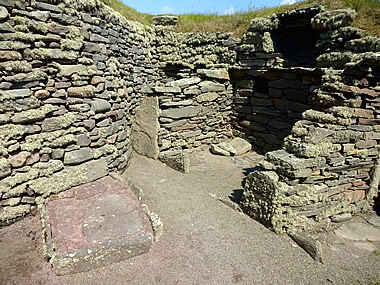
Wheelhouses are unique to the Northern and Western Isles of Scotland. They are characterised by thick, sturdy dry stone walls and a central hearth, with the area around the hearth divided by walls, like the spokes of a wheel. What these compartments were used for is unknown - perhaps they were bed recesses.
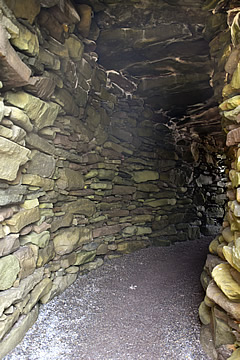
The upper parts of the "spoke" walls were corbelled and slabs of stone laid on top to cover the compartments. The centre was probably covered by a wood and thatch or turf roof. The fire and simple oil lamps would have provided light. No doubt they were warm places of refuge from the strong winds and cold weather.
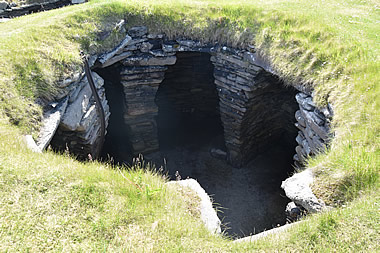
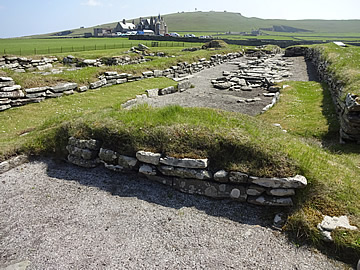
After some time the wheelhouses fell into disuse and simpler homes were constructed. In the latest of these a few stones with scratched designs typical of the Pictish era were found.
Around 900AD new settlers began to arrive. The Vikings, as they were known, may have had intermittent contact with the people of Jarlshof when they came to trade and then decided to stay. At first there was a single farm on the northern outskirts of the settlement which underwent many modifications and even rebuilding to form the core of the small village that grew here.
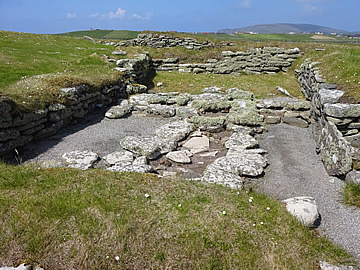
The new settlers brought a very different architecture with them which itself evolved. In the early period of the village the homes were long and rectangular with an integrated internal space at one end for cattle. Later the cattle were housed in separate buildings, possibly abandoned farmsteads, and later still the integrated byre became common again. There was a kitchen at one end and a large living area. This longhouse style, including an integrated byre, was in use in Shetland well into the twentieth century.
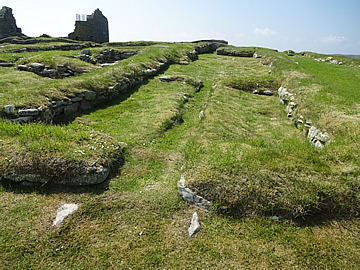
At any one time there seems to have been no more than four occupied dwellings, and more typically only one or two.
The Viking village lasted for about 400 years. In the late 1200s a new building was erected to the east of the Viking village, a farmhouse with a corn-drying kiln and a barn. Shorter and wider than the Viking houses, over the next 300 years it was rebuilt at least four times and what is now visible dates mostly from its last incarnation, around 1500, at a time when Shetland was no longer governed by Norway and had become part of Scotland.
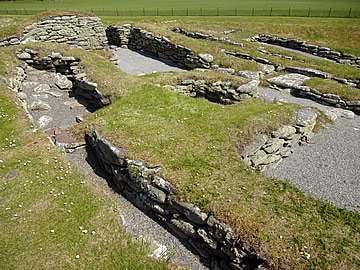
The final building on the site is the Laird's House, built at the end of the sixteenth century by Earl Robert Stewart and his son Patrick, who succeeded him in 1593. The Stewarts never lived here, leasing it to William Bruce. Patrick, known as "Black Patie", was an unpleasant man, whose son was hanged for rebellion in 1614 and his Patrick was beheaded the following year. The Bruce family moved to a new home on the site of the Sumburgh Hotel in the early 1600s and the building fell into disrepair. The courtyard was used for a time as a burial ground in the 1700s, the final stage in the long history of this fascinating site until excavations began.
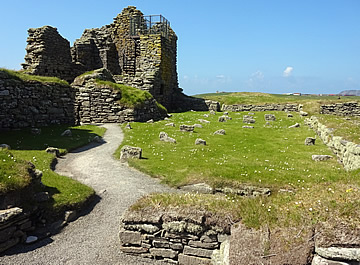
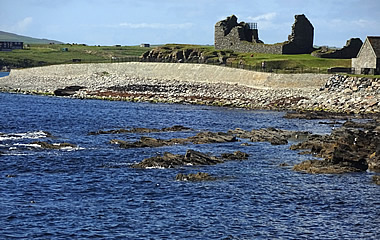
References